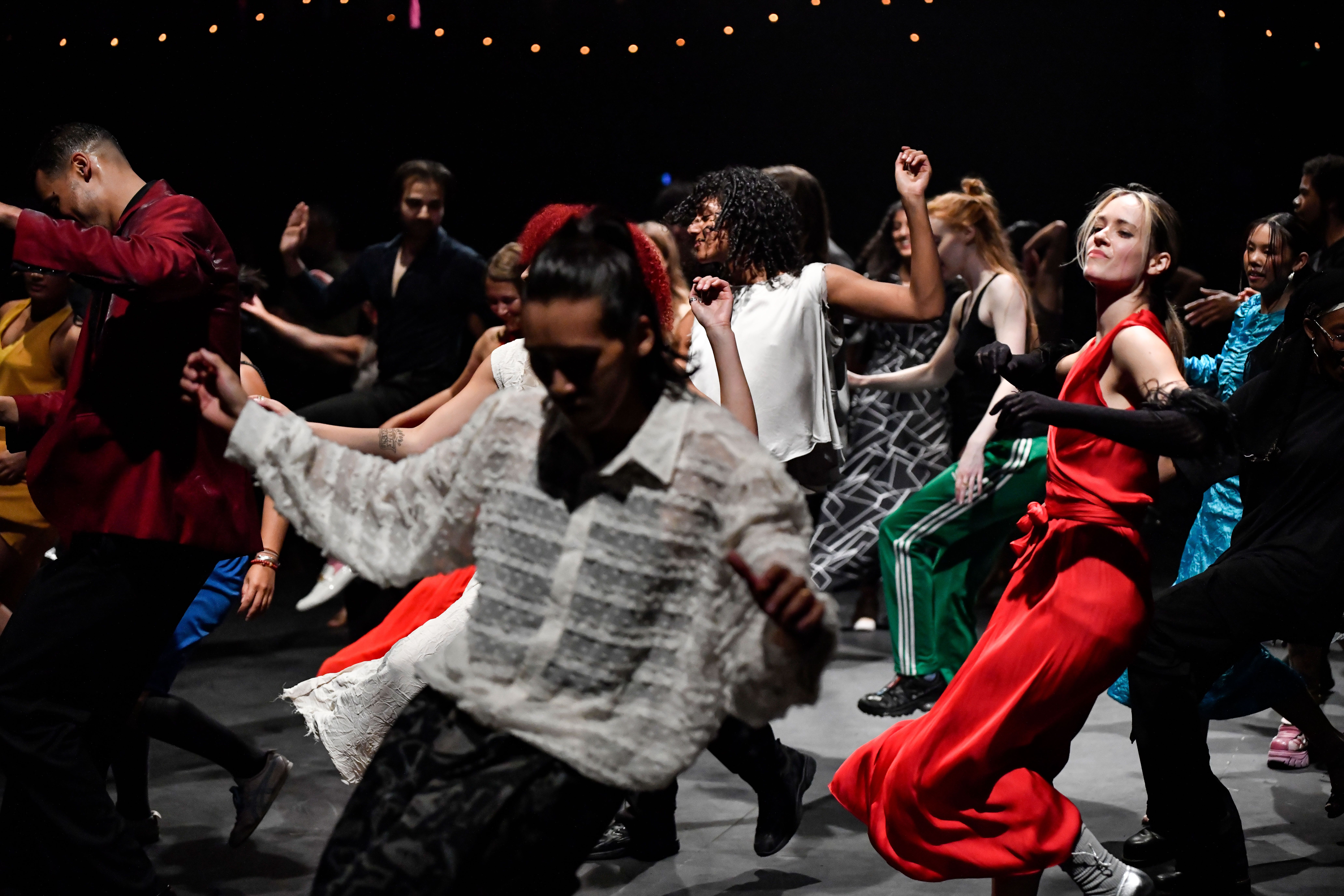Clod Ensemble & Nu Civilisation Orchestra
Barbican Centre
Mea culpa, mea culpa, this review will be part apology, part whinge and hopefully just a little amusing. Picture this, a rushed theatre critic, invited by a trusted PR person to his favourite venue, quickly skims the show’s blurb, sees jazz, dance and a transformed space. Scuttles down on the day in cowboy heels and a linen suit (this will be important later), ready for anything, or so he thought.
What greets him? Sarah Blenkinsop has really done a number on the dull seat/stage setup of the Barbican’s main hall. We go backstage (shock horror) and emerge on the stage (more whispers of shock) to hanging ropes with coloured balls attached, three ranged mini decks with cabaret-ish tables and a bar hidden behind, the normal seats stretch unused and unfortunately unattainable back into the gloom. There is a smaller stage (thank goodness) where the twelve musicians sit. My eyebrows are up, but still on my face. Various slinky people mill about in silks, satins, and sequins; some, we guess, are dancers, and other gorgeous audience members looking disquietingly dancer-like. We start to notice many comfy shoes on the civilians around us, worry sets in, prickling. Host and poetic renaissance person Chloe Carterr, a towering pillar of printed orange explains the concept. Now panic sets in, eyebrows hovering near my hairline.
An evening which I understood as a semi-immersive performance of legendary Jazz musician and composer Charles Mingus’s album The Black Saint and The Sinner Lady by Nu Civilisation Orchestra and dance company Clod Ensemble, is much more interactive than I first thought. Now my relationship with immersive theatre is like my relationship with mathematics: I respect it, and I am glad it exists but I don’t want to spend an evening in its confusing embrace. Hence the mea culpa, this was never going to be the show for me.
The concept is a solid one, however. The album in question was created by Mingus in 1963 at the Village Vanguard in New York, constantly improvised over six weeks and built to dance too. When the orchestra’s musical director Peter Edwards Herculean-ly translated the piece by ear, teaming up with a company (Clod Ensemble) that regularly pushes the boundaries between dancer and the audience it all made perfect sense. Warming us with three pieces by jazz’s future Romarna Campbell, Edwards himself and Paul Clark again resynthesises the piece from its 60s birth to the modern landscape of the genre. Moments of hedonistic abandon flash as dancers in all their fluid confidence twine with the shuttering and unsure real-life humans. Out of the crush of bodies, a circle is cleared and the more big band sections are physicalised by the company, hand soaring up in expressive arches, spinning down, crumbling Marianthi Hatzikidi’s heightened bouji club wear. The blast and bullish cacophony of the band playing the eponymous album, a jazz sibling to Stravinsky’s Rite of Spring: expansive, tripping you up, then laying you back down again, a lover less than a teacher. We get the classic waltz, Spanish flamenco elements, folk, and the defining jazziness that made it so very famous.
As a professional, I tried to get into the spirit. The aforementioned linen stopped me from camping down on the floor, and politeness only just stopped me from turfing one of the great seated ones into the fray. No, instead I clomped around on my unwieldy heels but was so taken aback by the concept my eyebrows tumbled onto the floor in front of me, and I was scared of stepping on them.
Like with any fantasy, reality has a habit of creeping in through the cracks. A lack of tables and chairs meant a rather tense stampede in the preshow, added to a long queue for the “on stage” bar meant a “us” and “them” mentality developed between the chair and chairless. Sight lines for them, I would imagine amazing, for us shovelled into the spaces between, less so. The cavorting audience again having a ball, yet obscuring a lot of the band’s wonderful work, gathering in a clustered pagan circle around Suzy Willson and Paul Clark’s spurting choreography. I never realised how much of the human sacrifice the ancient Celts must have missed at Stonehenge based on if you bought the ringside druid Iron ticket or the wooden general admission. Both I and my resolutely un-dancing date felt like goths at the family wedding refusing petulantly to dance to Mambo Number Five, grumpily trying to glimpse a flash of the dancers as they prowled picking victims to be dragged into the throng or pulling overzealous audience out of the choreographed sections (there’s always one). Parts of the evening looked like Greenwich Village in the 60s with outstretched hands and improvised revelry and parts looked like a dance class on a high end around the world cruise.
The issue is that this is neither fully in either world. Not a static focused performance nor a smoky sweaty gyrating jazz club. You may say I didn’t throw myself enough into the spirit and that is partly true, but I was unprepared and unwilling, biting back from shouting “Let the professionals do their stuff” for almost two hours, and that would tire anybody out.
Snatched tickets, Click here!



